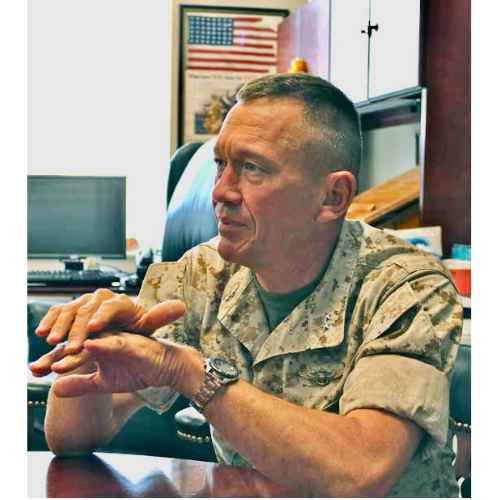By Robbin Laird and Ed Timperlake
In January 2024, we had a chance to do our final interview for our forthcoming MAWTS-1 book, namely with LtGen Davis. He was the CO of MAWTS-1 from 19 November 2004-7 July 2006 and had served as the XO for Col later MajGen Raymond Fox, his immediate predecessor.
Fox had become the CO of MAWTS-1 just prior to Operation Iraqi Freedom in 2003 and he along with most of MAWTS-1 went to that operation. After the war, they set up the first Desert Talon exercise which was focused on the integration of the Marine Corps force going to Iraq.
MajGen Fox underscored the key role which MAWTS-1 plays in training the trainers and driving innovation for an integrated USMC.
“The CO of MAWTS controls, the red, the blue and the white – the whole battlefield. This allows for very innovative scenarios and training for the students. And the WTI instructors and the students in the FINEX get to experience first-hand what combat integration and adversary efforts to break up an integrated force is all about.”
LtGen Davis built upon this perspective and underscored how MAWTS-1 was pushing the envelope of innovation as a core function of its approach to training. And because through the WTIs they were training the squadron trainers they were diffusing the drive for innovation forward.
Of course, Davis brought his own background and experience to the command. He was a Harrier pilot and had served with the Brits in West Germany and had learned their way of operating Harriers in a high-end Cold War threat environment every day. He also had written his Master’s Thesis in 1994 on the challenges of operating in an urban environment which became very relevant in the years to come in Iraq.
In his discussion with us, a major theme was how to work effective ways to weaponize the force. Force integration was key, but which weapons, for which missions and how to make sure that the force was effective as an integrated force capable of delivering the desired effects. The approach here was to provide flexibility to the force but to ensure that the force worked to deliver the desired effects which is a way of describing effective weaponization of the force.
Another key theme was operational effectiveness and operational excellence. On the effectiveness side, the transition to a predominance of precision guided munitions (PGMs) for the MAGTF and ACE and meant they adjusted the WTI course focus to emphasize the use of and optimization of that ordnance for throughout every sortie in the course.
On the operational excellence side of the ledger, Davis was tasked to operationalize safety at WTI and to reduce the mishap rate associated with WTIs in the fleet. Davis asked for an additional three days to be added to the WTI course academics and built a Tactical Risk Mitigation syllabus that helped WTIs fully understand risk, and develop strategies to help their units avoid the Blue Threat and focus more on mitigating the Red Threat to more effectively support the MAGTF.
While he was at MAWTS-1, they were anticipating the arrival of the Osprey and after that the F-35. This has been a virtual revolution in USMC operations and thinking. But “Dog” felt strongly that the Marines needed fifth gen to operate in the kind of environments which were clearly emerging with higher-end competitors.
They had done exercises which demonstrated that against a high end nation versus nation threat (no counter insurgency) only using 4th gen and lower legacy aircraft, the Marines would lose significant numbers of aircraft and not have the desired results against the target (mission fail).
As Davis noted: “In one strike we put 34 strikers against an integrated air defense system (air and ground threats) and we lost 1/2 the FA-18, Harrier and Prowler strike force and no one hit the target. Mission Fail. Therefore, I asked the USAF commander at Nellis to lend the WTI strike package 6-8 F-22s to run the same scenario next course – to expose the WTI students and MAWTS-1 staff to 5th generation capabilities and to understand how they could enhance the survival and lethality of the MAGTF in the near future.
“The next class’s strike had identical strikers and scenario with the addition of 8 F-22s. We killed all the bad guy fighters, destroyed or degraded the SAMS, achieved 100% mission success 8n the target and lost zero aircraft. It was an epiphany for the MAWTS-1 staff. After working with the F-22, it was obvious that fifth gen capabilities were necessary for the Marines to win in the nation state versus nation state threat environment.”
Lastly, Davis revamped the MAWTS-1 Air Officer Course to focus it on building MEU and Regimental Air Officers with the knowledge and skills needed to ensure that those units received the very best from their Air Officers, ultimately leading to a new MOS for MAWTS-1 certified Air Officers and making a pre-requisite to hold that billet.
The focus of MAWTS-1 on driving a way ahead for innovation for the Marines operating as an integrated force but incorporating new systems, new capabilities, standards and new con-ops was underscored by LtGen Davis as a key element in generating the kind of MAGTF needed to win the battles that loomed on the nation’s bow.
Featured Photo: LtGen “Dog” Davis during our 2017 interview in his office in Cherry Point when he was the head of Second Marine Air Wing.
Later this year, we are publishing a book providing our comprehensive look at MAWTS-1. The book is entitled: MAWTS-1: An Incubator for Military Transformation.
Until then our readers can purchase a book which brings together the 2023 interactions with MAWTS-1:


